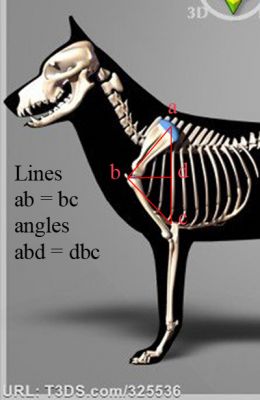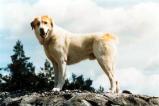
This is a placeholder text
Group text
by Abby Normal on 08 November 2011 - 14:11
Preston, great insight. As you say Dingo was not 'perfect' but his angles were only very slightly variant to the standard, with the exception of the croup, which Ibrahim illustrated, so I don't think it should be a great surprise that he was such a great mover. But as you say, angles are not the only factor in great movement or for that matter in a great dog, ligament, musculature, heritage and probably more importantly balance and moderate angulation overall. Certainly agree with your statement: Like Herr Martin or not, some experts claim it is not fair to blame him for what others did to screw up what perhaps only he could do properly himself.
Rik, I know very little of Am SL, but thought I read somewhere that they are bred to have particularly loose ligaments? You are right though, some do have phenomenal gaits.
by Gustav on 08 November 2011 - 15:11
Can I weigh in here....to me the breed is one of harmony, balance, and moderation in structure and conformation to allow form to follow function. Take for example Marko vom Cellerland, who by the degree of angle, length of proportions, etc., was a very flawed dog. BUT, he was very balanced, moved extremely well , and produced dogs structurally capable of enduring work through his structure. Now he was in direct conflict with the type of Canto in gait and structure, and ultimately faded into oblivion in the conformation world. I think Marko even won breed at the biggest All breed show in Europe at one point. He did not have the equipment for the extreme gait, but extreme is not what a GS should be in structure. He was a dog when you saw him move you just knew he was "right". Harmony, balance, and moderation, will not win in the conformation ring anymore, but it still looks and feels right to me. Dingo was a moderate, balanced dog that everything fit,(as with Marko), so that movement just looks right!
by Rik on 08 November 2011 - 16:11
| hello pod "I would be asking - at what point does the show ring stop in 'improving' construction and "phenomenal gaits"? |
|
that question is easy to answer and once again I point to the American Show Shepherd. When the singular goal of the show ring is gait, there is no stopping point in the pursuit. Not health, teeth, color, character, function or anything written in the standard. If you read into my post that I feel the show ring improves construction or that phenomenal gait should be the goal, I did not intend that at all. For whatever reason, it was determined that 90 degrees is the optimum for shoulder angle. I have never seen this and doubt it is achievable. Most seem to be 97 and up. If Ibrihims calculations are correct, the VA dog is 104 in the front and 105 in the rear. At least in theory, the dog should be pretty well balanced. Rik |
by pod on 08 November 2011 - 17:11
I think you have hit upon what illustates the main failing of the showring for me, in that there is no stopping point. There is always that pursuit for 'a little more' on the premise that, if a little is good more must be better, and yes, for the showring, that how it is because we are always looking for that outstanding dog, one that has a little bit more than the rest of the class.
But I do still agonise over what has happened to the German showline, where I thought the singular goal was also gait, as in the USA show type. Do modern day breeders really believe that the gait of the dogs of today is better than that of the 80s dogs?
by shri on 08 November 2011 - 17:11
by Ibrahim on 08 November 2011 - 20:11
This figure shows how many of us feel the bones on dog, mark them and then measure them, but it is approximate and not exact nor correct.

This figure shows the correct way they should be measured based on the study I mentioned earlier
.jpg)
by Abby Normal on 08 November 2011 - 22:11
I personally do not see Marko vom Cellerland as especially faulty to the standard, especially of the period, other than perhaps being slightly long in the body to other proportions. High, long, well defined withers, straight back and and balanced and moderate hind angulation. A very athletic looking dog IMO, and of a type which I am sorry to see gone from the showring.
Yes Ibrahim, I have understood this to be the case also, and I think that is what Pod is speaking of.
by pod on 09 November 2011 - 08:11
by pod on 09 November 2011 - 09:11
Whilst forehand angulation has increased to some extent over the years, it has not kept pace with the hindquarters. This may be because natural forces have prevented this. 90 degrees seems only to ever occur in achondroplastic breeds where it is aided by the concertina effect of limb shortening. Also the desire for high withers has contributed to keeping the forehand open.
The hindquarters are different in being more independant of the torso, giving greater flexibility to the angles. The desire for steeply sloping toplines has allowed the concertina effect on the hind angles, which gives this crouching appearance. The imbalance between fore and hind angles is largely responsible for the compensatory gaits we now see.
The foreward thrust of the hindfoot is so great that the forehand has to compensate by exaggerating the lift of the foreleg, and the backward extension of the hind limb is restricted to give the sickle hock effect. This creates a gait that may look impressive to some judges and ringsiders but is in fact very inefficient in energy usage, not to mention wear and tear on joints and soft tissue.
by Rik on 09 November 2011 - 10:11
As for the sickle hocks, I don't feel that this is 100% a product of over angled rears. I have seen lots of Am. dogs with severely over angled rears that still open up. The ones I have seen seem to trace back to one kennel in the U.S. I have yet to see it in German dogs, but I haven't come close to seeing them all.
For those unfamiliar with the term, sickle hocked refers to a rear that is unable to open or extend the hock. The rear give the appearance more of swinging through the motion than driving off the rear.
Fred's article on shoulder for those interested:
http://www.fredlanting.org/category/articles/page/2/
hth,
Rik
Contact information Disclaimer Privacy Statement Copyright Information Terms of Service Cookie policy ↑ Back to top




